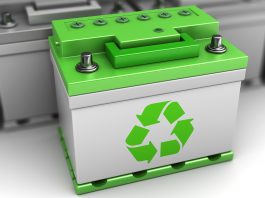Researchers at the University of Groningen have designed a large-scale flow battery that can store power in a simple organic compound.
In order to maintain an adequate and intermittent supply of green electricity, large-scale storage is necessary to ensure that power grids are kept stable. At present, normal batteries do not scale well enough to sufficiently perform this function.
Therefore, the utilisation of large-scale flow batteries – which store electricity in a fluid – is an advantageous option to scientists trying to develop green energy solutions.
However, these batteries comprise of high-priced rare metals. Now, scientists at the University of Groningen, the Netherlands, have constructed a flow battery electrolyte that could offer a solution to this difficulty.
The team’s results were published in the Journal of the American Chemical Society.
How do flow batteries differ from regular batteries?
On a surface level, flow batteries are not massively different to the ordinary batteries that we utilise for every day purposes. The primary way that the flow battery differs from a typical battery is that the energy is stored in two separate fluids with dissolved chemicals for charge storage.
Electricity is stored and then released by pumping these fluids through an electrochemical cell that comprises a membrane, whereby ions can be exchanged. The energy content of a battery such as this is easily scalable by simply using larger storage tanks for the fluids.
China is a great example of a country currently utilising flow batteries to reduce the variability in green electricity production.
Edwin Otten, Associate Professor of Molecular Inorganic Chemistry at the University of Groningen, explained: “Large-scale storage capacity is needed when intermittent sources, such as solar and wind energy, become more prominent in the electricity mix, because the grid might get destabilised.
“The type of battery that the Chinese use was designed in the1980s and is based on a solution containing vanadium.”
Vanadium
This hard, silvery-grey, malleable transition metal is rarely found in nature and can only mined in a few places on Earth: “This means that the supply cannot always be guaranteed, and it is rather expensive,” Otten said.
As well as this, it necessitates a special membrane to separate the two fluids, which further drives up the costs. Therefore, Otten’s research group, alongside colleagues from the University of Eindhoven in the Netherlands and the Technical University of Denmark, set out to construct a novel type of flow battery material.
Developing a symmetrical battery
“We wanted a symmetrical battery where both tanks contain the same fluid,” added the researcher. “Also, we wanted it to be based on an organic molecule rather than on a metal”.
Symmetrical batteries have been created by connecting the molecules that are used on both sides together and filling both tanks with the resulting hybrid molecule.
“The drawback of this approach is that only one part of the molecule is used on either side. And, during use, reactive radicals appear that degrade over time. This makes stability a problem.”
Thus, Otten and his team decided to employ a unique method. They searched for a single molecule that is stable and that can accept or donate electrons and could be utilised on both sides of the battery.
Blatter radical compound
The most encouraging compound was a Blatter radical, a bipolar organic compound that can either accept or donate an electron in a redox reaction. “The molecule that we selected was also intrinsically stable,” explained Otten.
They examined the compound in a small electrochemical cell. It worked well and stayed stable over 275 charge/discharge cycles. “We need to bring this up to thousands of cycles; however, our experiments are a proof of concept. It is possible to make a symmetrical flow battery that has good stability.”
“Another advantage of our symmetrical design is that it is not a big problem if some of our compound crosses the membrane during use,’ observed the scientist. “This could result in a slightly higher volume in one of the tanks, but any imbalance is easily restored by simply reversing the polarity.”
For the duration of their experiments, they have demonstrated that this operates as predicted. Other experimental designs of symmetrical batteries were not stable enough to get the number of cycles necessary to prove this.
Going forward, the researchers intend to develop a water-soluble version of the Blatter radicals. The majority of flow cells are constructed for water-based fluids, as water is cheap and not flammable. Another important step is to increase the stability and solubility of the Blatter radical and test it on a larger scale. Otten concluded: “The crucial test is to see whether our compounds will be stable enough for commercial applications.”









